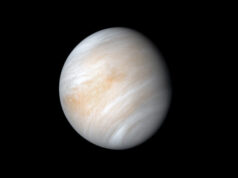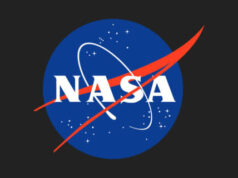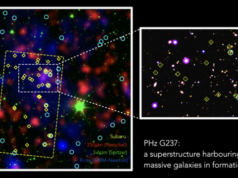This infrared image gives an unprecedented view of the southern aurora of Jupiter, as captured by NASA’s Juno spacecraft on Aug. 27, 2016.Credit: Photo courtesy of NASA.
When a NASA spacecraft made its first full orbit around Jupiter, a University of Iowa instrument on board recorded haunting sounds befitting the Halloween season.
The UI instrument was listening to Jupiter’s auroras, light shows similar to the northern and southern lights on Earth but on a vastly larger scale. The radio emissions cast by Jupiter’s auroras were recorded by the UI instrument, called Waves, as the Juno spacecraft traveled about 2,600 miles above Jupiter’s swirling clouds. Those emission recordings were then converted into sound files by UI engineers.
The emissions from Jupiter were discovered in the 1950s but had never been analyzed from such a close vantage point, according to NASA.
“Jupiter is talking to us in a way only gas-giant worlds can,” says Bill Kurth, research scientist at the UI and co-investigator for Waves. “Waves detected the signature emissions of the energetic particles that generate the massive auroras that encircle Jupiter’s north pole. These emissions are the strongest in the solar system. Now we are going to try to figure out where the electrons that are generating them come from.”
UI Waves team members — Kurth, professor Don Gurnett, associate research scientist George Hospodarsky, and post-doctoral researcher Masafumi Imai — were attending a Juno scientific meeting in late August when data rolled in from Juno’s first close flyby of Jupiter, known as Perijove 1. It was a big moment, the first up-close sampling of the auroras generated by the largest planet in our solar system.
Find your dream job in the space industry. Check our Space Job Board »
“Most of the space missions I’ve been involved in, you go someplace for the first time…everyone has a preconceived notion of what you might detect,” Kurth says, “but the details are waiting to be discovered. The details are kind of like a puzzle, and when you begin to put these pieces together, the physics behind it, you understand better.”
The scientists want to learn how electrons and ions are accelerated along magnetic field lines above Jupiter to eventually collide with the atmosphere, creating the bursts of light that become the auroras. To do that, the Waves instrument will sample plasma waves along different segments in the magnetic field lines with each of its orbits around Jupiter.
Kurth likens plasma to a stringed instrument. “If you pluck a string on a violin, the string vibrates,” he says. “The vibrating string is like the plasma itself; in the plasma it is the charged particles that are moving.”
Yet those radio waves can’t be heard. Instead, they need to be “downshifted” to the audio range, Kurth says, and then compressed to turn multiple hours of measurements into an abbreviated soundtrack that captures the greatest hits, so to speak. This translation is performed by UI senior engineering associate Don Kirchner.
“We like to listen to them. We figure if we like to listen to them, others will too,” Kurth says.
A camera aboard the spacecraft captured high-resolution views of the Jovian atmosphere and the first glimpse of Jupiter’s north and south poles.
The Aug. 27 flyby was the closest the Juno spacecraft will get to Jupiter. Thirty-five more close flybys are planned during Juno’s mission, which is scheduled to end in February 2018.
The UI scientists can’t wait to learn what’s next from Waves’ next measurement, which will happen on Nov. 2.
“It just kind of whets our appetite for what to expect,” Kurth says.
Source: University of Iowa











